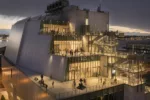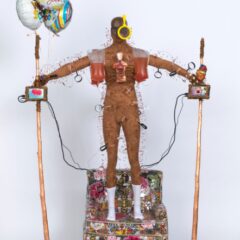The title of this article ends an inscription in a fraktur love letter (liebesbrief) written to Barbara Muller around 1800 by a now-anonymous doter. It is preceded by, in elaborate handwriting, “The heart of mine shall be devoted to you. See, my girlfriend, you are beautiful… Your eyes are like the eyes of doves between your braids. Your hair is like the flock of goats that was shorn unto the mountain Gilead.” I imagine the author penning the message, overwhelmed by the rush of passion and then quickly regretting what he wrote. The fraktur exhibit in the Free Library’s Rare Books Department (3rd Floor, you have to be buzzed in) is open until next Tuesday November 10th. Read more about this fantastic exhibition after the jump.
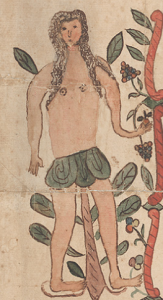
Pennsylvania Germans created fraktur (decorated documents) to serve as records of important life events: birth and baptisimal certificates (Geburts-und Taufschein); confirmation certificates (Konfirmationsschein); marriage certificates (Trauschein), death certificates (Denkmal). Fraktur also served as a sort of Pennsylvania German greeting card: house warming blessings (Haussegen); baptismal blessings (Taufwunsch); New Year’s Greetings (Neuesjahreswunsch). And many fraktur were used to teach children how to write and read. They were mostly made between 1683-1850, when many Germans were immigrating from the knight’s dominions and religious principalities that were to become unified Germany in 1871. Fraktur features the easily identifiable thick black broken (fractur, from the Latin “fractus”) type, and watercolor and ink imagery that includes tulips, double eagles, thistles, lillies, signs of the zodiac, and depictions of everyday (often rural) life.
The drawing style in the exhibit seems strikingly contemporary. The folk-art illustrative stylistics are reminiscent of artists whose work is popular now, like Martin Ramirez, James Castle, Edward Gorey, and Warhol’s early drawings. The drawing and line quality is often whimsical, cartoonish, expressive, full of character and naievete. Conversely, the handwriting is extremely controlled and stylized compared to the blobby Adam and Eve and the squashed angels with their deformed trumpets.
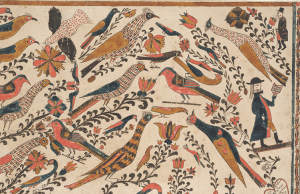
I loved the characters in Variety of Birds (anonymous artist, 1816). In the drawing, the dozens of splendid birds with startled expressions have taken over the world of two small, pious-looking men.
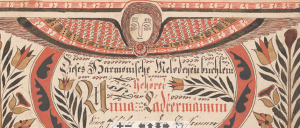
The Angel Bookplate (Bücherzeichen) for Anna Lädtermänn by David Kulp features that Egyptian-esque (wings of Isis) element of fraktur in the angel’s wings. The handwriting reads, “This little harmonious melody book belongs to Anna Lädtermännin, singing student in the Deep Run School. Written the 12th of January anno 1812.”
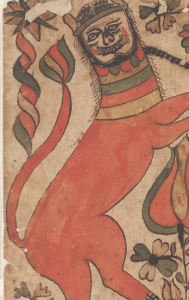
Another fantastic fraktur religious text is by Christian Beschler in 1799 which features an even more unusual-looking German medieval lion-cum-human opposite a unicorn. In between them is a set of wings with what looks like a hairy, bucktoothed angel smiling (?) delivering the message, “God, you are so rich today.”
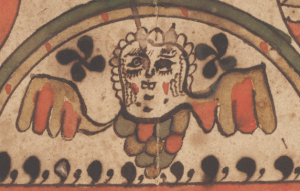
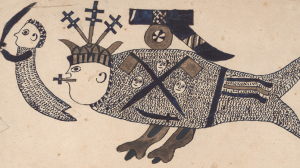
The Wunderfisch reminds me of warfare-related drawings that my brothers made as children: as though one cannon were not enough to attack and threaten, to attack the Wunderfish (half crowned man, half fish, the feet of swans) you would first have to get past its sword-armed guard, then face the creature itself with a cannon on its back, three swords in its head, a sword in its mouth, and skulls mounted on its scaly body (previous kills). Incredibly dangerous.
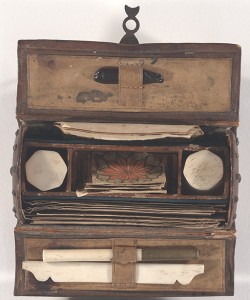
The exhibit also displays the box that the fraktur artist (the scrivener) used to hold tools. It is tiny (5 inches long) an contains a bone straightedge, ink powder, and pen nibs. Apparently in the 1700s printers began to sell more generic fraktur woodcuts that only required inscription and coloring-in. A very thick woodblock is on display next to the kit.
I would suggest seeing the Pennsylvania German gallery of sgraffito plates and furniture at the PMA as an addendum to the fraktur exhibit at the Free Library. The plates often feature similar humorous, profane inscriptions and imagery. These plates always reminded me of a brass plate I would see while walking through the medieval section of the Met. The plate is from the Netherlands, was made in the 1480s and is titled Wife Beating Husband.
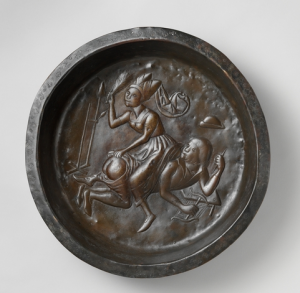
If you miss the show, the fraktur collection of the Free Library of Philadelphia is available online (it’s great to peruse). However, you really have to see these pieces to appreciate them (some are surprisingly large), and it gives you a chance to poke around the rare book area. Monday-Friday, 9:00AM-5:00PM, tours of the department at 11:00.


